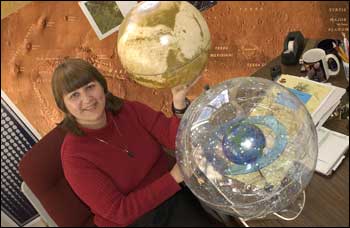Astronomer Nadine Barlow doesn’t think declassifying Pluto’s planet status is a done deal.
In fact, she’s hoping the International Astronomical Union’s new definition of a planet will get kicked out of orbit when the group reconvenes in three years.
“A lot of planetary scientists do not feel the new definition of a planet is a very good one, and there is a huge controversy going on in the planetary community as whether or not to accept it,” Barlow said. “I wouldn’t be surprised if the definition eventually gets readdressed. We need a good definition for a planet, but this is not it.”
Barlow, an associate professor in physics and astronomy at NAU and a member of the Division for Planetary Sciences Executive Committee for the American Astronomical Society, said the definition was arrived at “hastily.”
The International Astronomical Union sought recommendations from the Division for Planetary Sciences to form a new planet definition committee after its original committee became deadlocked on the topic.
The second committee represented the public’s view more because it included scientists, historians, journalists and authors. It defined a planet as an object orbiting a star that is massive enough so that its gravity would pull it into a sphere.
“That’s the definition that would have led to a 12-planet solar system with Pluto and Charon—its largest moon—being a double planet,” Barlow explained. “We were satisfied with that definition and endorsed the resolution. I figured Flagstaff would be really happy. Charon was discovered here as well, so then we could claim two planets discovered in the Flagstaff area.”
But that was not the final frontier for Pluto’s fate.
According to Barlow, things went amiss when the resolution was presented to the International Astronomical Union at its general assembly in Prague. Those in attendance (about 5 percent of all the astronomers worldwide) preferred a new definition produced within one week at the meeting. “Most of us could not attend the meeting because we lacked travel funds, time or we had academic commitments.”
As a result, the new definition requires that a planet not only orbit the sun, but that it is spherical and can clear out its orbital neighborhood of debris.
Barlow dislikes the new definition because neither “neighborhood” nor “debris” are well defined, which “leaves too much open for discussion. Does ‘debris’ include things like spacecraft? If so, then the Earth might not qualify as a planet,” she explained. “‘Clear out’ means there can’t be other objects floating around and the object is massive enough to kick anything that enters its space out of the area. It means that Pluto does not qualify as a planet because it is in a region of space called the Kuiper Belt, an area where there is a bunch of icy debris.”
Barlow said a committee of the International Astronomical Union that specifically looks at Solar System issues, chaired by Ted Bowell, an astronomer from Lowell Observatory, was recently given the assignment of specifically defining what it means when you “clear out” an orbital neighborhood.
Bowell’s research centers on the discovery and orbit computation of near-Earth asteroids and comets, and his committee’s input on the planet issue could lead to yet another definition for Pluto, which is now categorized as a dwarf planet.
Barlow said the next committee designated to finalize the definition of a planet will be composed of scientists who study motion and how heavenly bodies interact with each other and not by surface scientists like her, but “I will continue to have strong feelings about Pluto’s definition,” she said.
Meanwhile, Barlow will continue her research in the familiar neighborhood of the subsurface of Mars, where she believes much of the water in the form of ice is primarily located. What she finds in the cosmos today could make a difference in tomorrow’s space exploration.
“My research focuses on Martian impact craters and what they can tell us about the distribution of subsurface water and/or ice reservoirs,” she said. “Part of the reason we are searching for water is to be able to provide water for eventual colonies on the planet.”
Barlow said one of the controversies facing her research is whether the impact crater features that she studies tell scientists about near surface ice or if atmosphere is playing a role in creating them. To determine the answer, Barlow is also conducting research on Ganymede, a moon of Jupiter that has an icy surface but no atmosphere.



